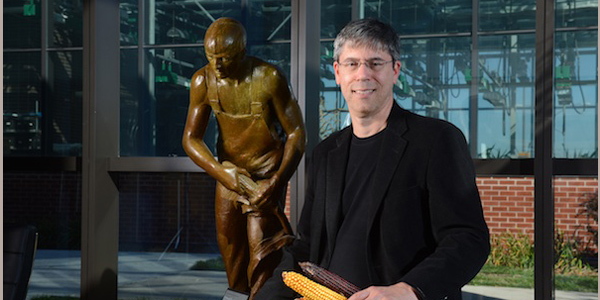
The Future Of Agricultural Research: Collaboration In A Rising Tide Of Data
Growing world population and rising standards of living are increasing global demand for the products of agriculture.
To enable scientists to more readily identify and ultimately harness genes that contribute to agricultural productivity, the genetic blueprints of many crop and livestock species have been deciphered over the past decade. Iowa State faculty members have contributed to several of these high-profile genome sequencing projects.
Genetic Blueprint
An organism’s genetic blueprint—its genotype—is not, however, sufficient to fully explain its growth and development—its phenotype. Instead, an organism’s genotype interacts with its environment to define its phenotype, such as its yield or growth rate. Understanding how particular genotypes result in specific phenotypes under specific environments is a core goal of modern biological research.
Ultimately this understanding will allow agricultural scientists to predict the phenotype of a given genotype in a given environment. For example, we seek to predict the performance of a given corn hybrid in a specific field under a specific set of agronomic practices. The ability to make accurate predictions of this type will enable farmers to select the optimal hybrids for a given field in a given year.
Similarly, and analogous to “personalized medicine,” such predictions will allow farmers to provide the optimal management strategy for livestock with defined genotypes. In addition, these predictions will facilitate the more efficient breeding of crops and livestock with commercially useful characteristics.
The prediction of phenotypes from genotype and environment is complicated by the fact that different genotypes respond to different environments in different ways. Hence, it is necessary to understand not only the roles of genotype and environment on phenotype, but also the influences of interactions between genotype and environment on phenotype. To parse these complex interactions and develop sufficient biological understanding to develop predictive models for use by breeders, agronomists and animal scientists, it will be necessary to obtain phenotypic data from many genotypes in many, well-characterized environments.
Advances in DNA sequencing technology, driven by the human genome project, are enabling scientists to readily characterize the genetic variation of hundreds to thousands of individuals in agricultural species. More challenging is doing the same for environments and phenotypes.
New tech to tackle Big Data
Iowa State University agricultural researchers in partnership with engineers are developing novel, sophisticated sensors to measure large numbers of diverse environments and phenotypes at high throughput in real time. This initiative will generate massive amounts of data that will dwarf the data deluge generated by genome sequencing projects and will therefore require a new approach to data.
The buzzword “Big Data” encompasses the acquisition, management, analysis and interpretation of information with extreme volume, variety, velocity (rate of acquisition), veracity, variability and complexity. The Big Data paradigm enables researchers to more quickly formulate and test novel hypotheses. Iowa State scientists are using the approaches of Big Data to develop statistical models that enable the prediction of phenotypes based on genotypes and environmental data.
Iowa State breeders and geneticists together with computational scientists are making use of Big Data to better understand and model crop and livestock growth and development.
The results of these collaborations promise to be both exciting and wide-reaching. They will advance our understanding of biological processes. They will revolutionize our ability to create crops and livestock that exhibit enhanced resilience to variable weather patterns associated with global climate change, helping to ensure a plentiful and stable supply of food and feed. And, importantly for Iowa, they offer substantial new opportunities for Iowa State to contribute to economic development.



